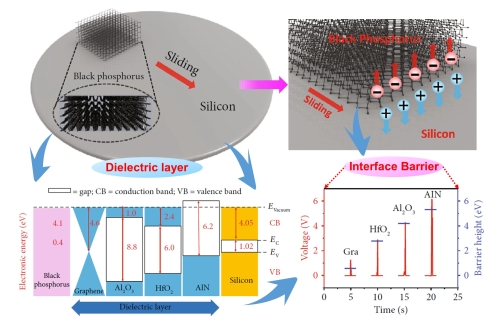
-
Hot electron transport in dynamic black Phosphorus/Insulator/Si heterojunction for tunable direct-current generator
2019-11-07
Fig. 1 Experimental design and results of the dynamic black phosphorus/Si generator.
Since the formal discovery of heterojunctions in the mid-20th century, solid-state electronics have been considerably advanced, which has laid the foundation for the modern information society. However, all the heterojunction devices are based on static heterojunctions, dynamic heterojunctions have rarely been explored.
Prof. Shisheng Lin’s Team at Zhejiang University has discovered that the moving heterojunction can output direct current and developed a tunable direct-current generator by engineering the interface between the black phosphorus and Si in the heterojunction, whose voltage output can be accurately designed through changing the barrier height. Prof. Shisheng Lin has disclosed that the hot carriers transport process induced by the carrier rebounding effect is the origin of the voltage output.
“We pointed out the physical picture of the generator is based on the redistribution of electrons and holes caused by the mechanical energy input, which can have a great impact on the design and improvement of the dynamic junction generators.” said Shisheng Lin, who led the research.
The new development of intelligent and wearable electronic heterojunction devices puts forward new requirements for in situ electric energy acquisition technology: lightweight, integrated, portable and flexible, which is still the technical difficulty of conventional generators. It is increasingly important to create a lightweight and miniaturized electric generator with this new physical picture.
The study was published recently in Research(Tunable Dynamic Black Phosphorus/Insulator/Si Heterojunction Direct-Current Generator Based on the Hot Electron Transport, DOI: 10.34133/2019/5832382), the first Science Partner Journal recently launched by the American Association for the Advancement of Science (AAAS) in collaboration with the China Association for Science and Technology (CAST). The paper Shisheng Lin is an associate professor of college of information science and electronic engineering in Zhejiang University. https://spj.sciencemag.org/research/2019/5832382/.
“In particular, we have proposed the physical picture of the dynamic heterojunction based on the rebounding effect under the ultrahigh built-in electric field at the interface, breaking the balance between the drift current and diffusion current and generate an electrical output.” Lin said about the work mechanism. “This process is similar to a capacitive charge/discharge process of PN junction capacitance during the movement, indicating the junction capacitive and interface barrier height play the key roles in the electricity generating.”
The intrinsic anisotropy of black phosphorus arising from the lattice structure produces extraordinary electronic, transport, and mechanical properties exploited in the dynamic heterojunction generator. This dynamic heterojunction generator also exhibits an ultrahigh current density, which is ~103 times higher than triboelectric nanogenerators and ~104 times higher than piezoelectric nanogenerators. But the voltage still required for enhancement to meet the static heterojunction device application timely and directly.
Lin and his team met the challenge and enhanced the voltage output up to 10 times with the interface energy level engineering of inserting dielectric layers. A voltage up to 6.1V was achieved, which was even higher than the interface barrier height, indicating the hot carriers transport in the insulating layer under the ultrahigh built-in electric field of about 6×106V/cm. Lin said the output voltage can be delicately adjusted by inserting insulating layer, and hot electrons will still transfer across the interface through the tunneling and hopping effect.
Especially, the dynamic black phosphorus/AlN/Si heterojunction can be used to directly and synchronously light up light-emitting diodes, indicating its potential to convert ubiquitous mechanical energy into electric energy. It is a promising candidate for novel portable and miniaturized power sources in the in situ energy acquisition field. The matching of internal resistance between the static and dynamic heterojunction can reduce the loss of power and realize the integration of dynamic and static heterojunction, which is used to realize the “information-energy integrated chip”.
This work was supported by the National Natural Science Foundation of China (Grant Nos. 51202216, 51502264, and 61774135) and the Special Foundation of Young Professor of Zhejiang University (Grant No. 2013QNA5007). Doctor Yanghua Lu, a member of Lin's research group, served as the paper’s first author.
Tag: Emerging materials research
